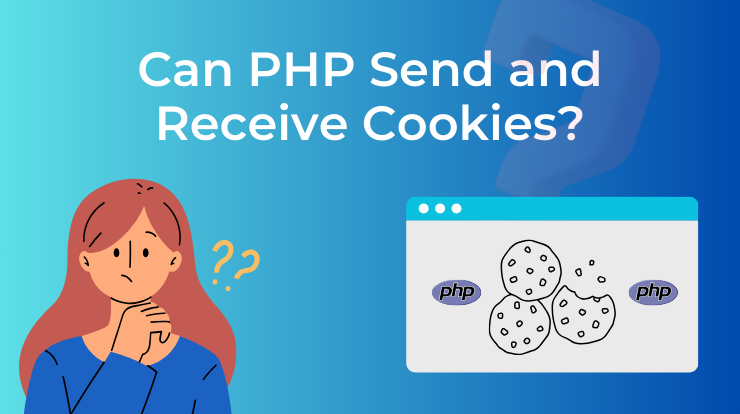Yes, PHP can send (set), receive (read), and delete cookies.
Are you ready to delve into exploring the world of PHP cookies? If you’ve ever wondered how websites remember your preferences or keep you logged in, cookies are the secret mechanism.
In this guide, we’ll take a bite-sized approach to understanding how PHP can send and receive these little packets of data, making your web experience smoother and more personalized.
What are Cookies?
First things, let’s unwrap the mystery behind cookies. Simply put, cookies are small pieces of data stored on your browser by websites you visit.
They serve as a way for websites to remember information about you, such as your login status, language preference, or items in your shopping cart. Cookies enable a more customized browsing experience by allowing websites to tailor content specifically to you.
Let’s see the examples of PHP cookies and how you can send, receive, and delete cookies.
Sending Cookies with PHP
Now, let’s talk about how PHP can send cookies to your browser. Sending cookies is like giving your browser a little note to remember something for later.
With PHP, you can use the setcookie() function to send cookies to the client’s browser. Let’s take a look at a simple example.
<?php
// Set a cookie named 'username' with the value 'JohnDoe'
setcookie('username', 'JohnDoe', time() + (86400 * 30), '/');
?>In this example, we’re setting a cookie named ‘username‘ with the value ‘JohnDoe‘. The third parameter represents the expiration time of the cookie, which is set to 30 days from the current time. The last parameter ‘/‘ specifies the path on the server in which the cookie will be available.
Receiving Cookies with PHP
Receiving cookies is as easy as indulging in your favorite dessert. Once a cookie is sent to your browser, PHP can effortlessly retrieve its value. Let’s see how you can receive cookies using PHP.
<?php
// Check if the cookie named 'username' is set
if(isset($_COOKIE['username'])) {
// Display the value of the 'username' cookie
echo "Welcome back, " . $_COOKIE['username'] . "!";
} else {
echo "Welcome, Guest!";
}
?>In this code, we first check if the ‘username‘ cookie is set using the isset() function. If the cookie exists, we retrieve its value using the $_COOKIE superglobal array.
Deleting Cookies with PHP
The same setcookie() function that you use to create cookies can also be used to delete them. By setting the cookie’s expiration time to a past date, you essentially tell the browser to discard the cookie. Here’s how you can delete a cookie using PHP.
<?php
// Set the expiration time of the cookie to the past
setcookie('username', '', time() - 3600, '/');
?>In this example, we’re setting the expiration time of the ‘username‘ cookie to one hour ago, effectively deleting it from the browser’s storage. Remember to set the same path and domain parameters as when you originally set the cookie to ensure that you’re deleting the correct cookie.
Conclusion
In conclusion, PHP offers robust functionality for sending, receiving, and deleting cookies, empowering developers to create personalized and dynamic web experiences.
By understanding how cookies work and implementing best practices for handling them securely, you can enhance the usability and security of your web applications.
PHP Tutorials
FAQs
A PHP cookie is a small piece of data stored on a user’s browser by a PHP script. It serves as a means of retaining information about the user’s interactions with a website, such as login status, preferences, or session data.
PHP uses the setcookie() function to send cookies to the client’s browser. This function allows developers to specify the cookie’s name, value, expiration time, and other parameters.
Yes, PHP can receive cookies sent by the client’s browser. Developers can access cookie values using the $_COOKIE superglobal array, making it easy to personalize user experiences based on stored data.
Deleting cookies with PHP is simple. By setting the cookie’s expiration time to a past date using the setcookie() function, you effectively remove it from the browser’s storage.
Encrypt sensitive data before storing it in cookies, set the Secure and HttpOnly flags for cookies containing sensitive information and always validate and sanitize cookie data to prevent security vulnerabilities.
When a PHP script sends a cookie to the user’s browser using the setcookie() function, the browser stores this data locally. Subsequently, with each request to the website, the browser sends the cookie back to the server, allowing the PHP script to access and utilize the stored information.
PHP cookies have various applications in web development, including personalizing user experiences, tracking user preferences, managing session data, implementing shopping carts, and maintaining user login status across multiple pages.







